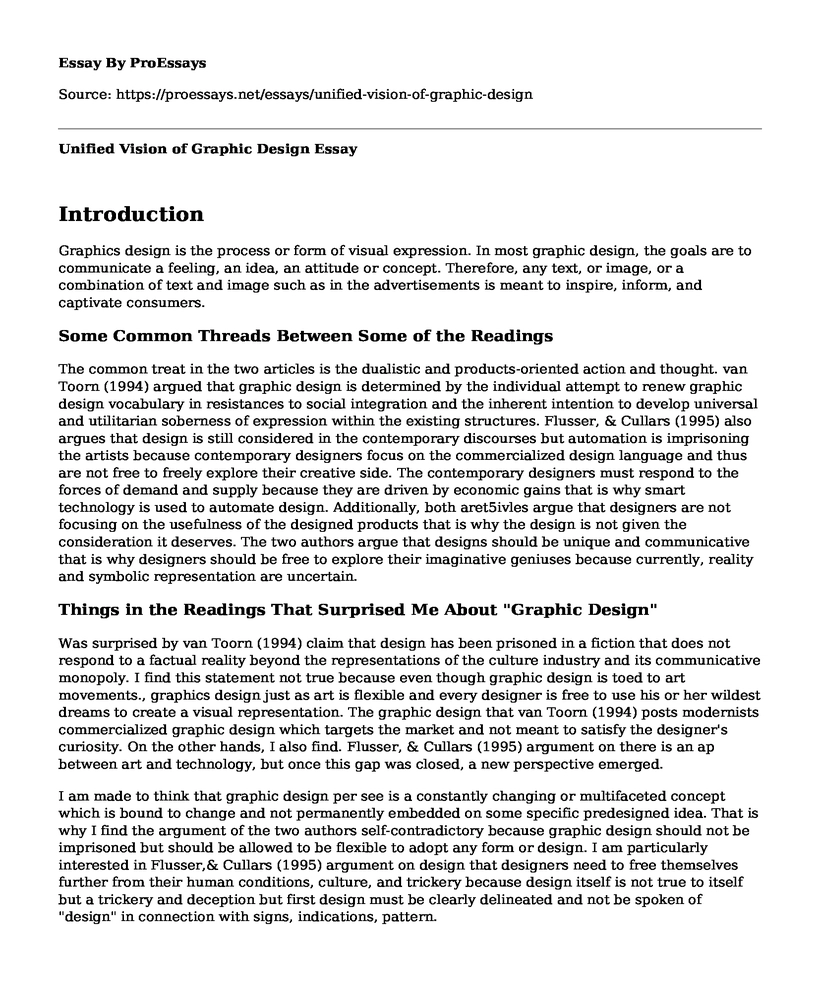Introduction
Graphics design is the process or form of visual expression. In most graphic design, the goals are to communicate a feeling, an idea, an attitude or concept. Therefore, any text, or image, or a combination of text and image such as in the advertisements is meant to inspire, inform, and captivate consumers.
Some Common Threads Between Some of the Readings
The common treat in the two articles is the dualistic and products-oriented action and thought. van Toorn (1994) argued that graphic design is determined by the individual attempt to renew graphic design vocabulary in resistances to social integration and the inherent intention to develop universal and utilitarian soberness of expression within the existing structures. Flusser, & Cullars (1995) also argues that design is still considered in the contemporary discourses but automation is imprisoning the artists because contemporary designers focus on the commercialized design language and thus are not free to freely explore their creative side. The contemporary designers must respond to the forces of demand and supply because they are driven by economic gains that is why smart technology is used to automate design. Additionally, both aret5ivles argue that designers are not focusing on the usefulness of the designed products that is why the design is not given the consideration it deserves. The two authors argue that designs should be unique and communicative that is why designers should be free to explore their imaginative geniuses because currently, reality and symbolic representation are uncertain.
Things in the Readings That Surprised Me About "Graphic Design"
Was surprised by van Toorn (1994) claim that design has been prisoned in a fiction that does not respond to a factual reality beyond the representations of the culture industry and its communicative monopoly. I find this statement not true because even though graphic design is toed to art movements., graphics design just as art is flexible and every designer is free to use his or her wildest dreams to create a visual representation. The graphic design that van Toorn (1994) posts modernists commercialized graphic design which targets the market and not meant to satisfy the designer's curiosity. On the other hands, I also find. Flusser, & Cullars (1995) argument on there is an ap between art and technology, but once this gap was closed, a new perspective emerged.
I am made to think that graphic design per see is a constantly changing or multifaceted concept which is bound to change and not permanently embedded on some specific predesigned idea. That is why I find the argument of the two authors self-contradictory because graphic design should not be imprisoned but should be allowed to be flexible to adopt any form or design. I am particularly interested in Flusser,& Cullars (1995) argument on design that designers need to free themselves further from their human conditions, culture, and trickery because design itself is not true to itself but a trickery and deception but first design must be clearly delineated and not be spoken of "design" in connection with signs, indications, pattern.
The Role of Manipulation in Graphic Design and Similarity Between Flosser’s and Van Toorn’s Critiques
The goal of graphic design is to influence or trick uses to take a specific action that they are not likely to take. Without manipulation in graphic design, a graphic designer might not achieve their goals. Therefore, graphic designers must adopt strategies, designers or psychological principles that can be intuitively used to influence or elicit design responses. Both Flusser's and Van Toorn's critiques argue that the designer's actions have been socially oriented into a complex system which prevents them from being analytical in their freedom. Both authors argue that the artists are no longer freely using their imaginative power to address the communicative realities and that is why technology and automation are winning in design war.
References
Flusser, V., & Cullars, J. (1995). On the Word Design: An Etymological Essay. Design Issues, 11(3), 50. doi: 10.2307/1511771
Van Toorn, J. (1994). Design and Reflexivity. Graphic Design Theory.
Cite this page
Unified Vision of Graphic Design. (2022, Mar 07). Retrieved from https://proessays.net/essays/unified-vision-of-graphic-design
If you are the original author of this essay and no longer wish to have it published on the ProEssays website, please click below to request its removal:
- Crash Film - Presentation Example
- Iconography, Symbolism, and Functions of Stained Glass Windows of Gothic Cathedrals
- The Impact of Social Media on Society and Businesses Paper Example
- Theme Construction in Kurosawa's Dreams
- Essay Sample on Vincent Van Gogh's "The Starry Night"
- Love Story for Tongming Xue
- Motown: A Cultural Phenomenon in Music Genres - Essay Sample







